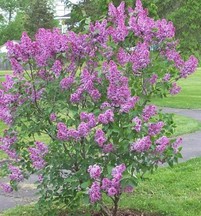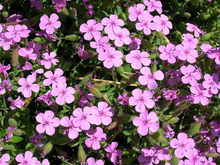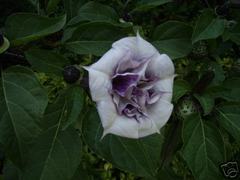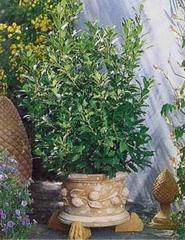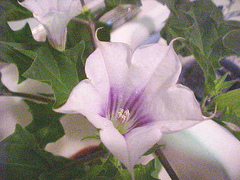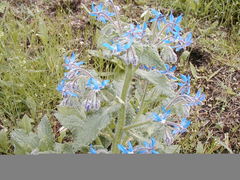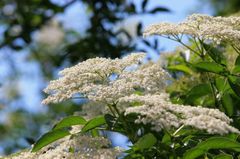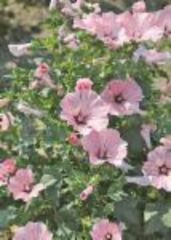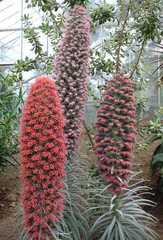Page Three
More herbs, flowers, and trees
Orange Jasmine
Orange Jasmine - Mock Orange
Murraya paniculata
Sometimes referred to as Mock Orange, this lovely tropical plant is best known for its fragrant white blossoms and gorgeous evergreen foliage. Easy to care for, it tolerates most conditions and will grow well in partial shade. What an amazing aroma! The strong orange-like scented flowers are abundant in the spring and summer and even in winter when grown with decent light. The blooms are followed by bright ornamental red fruits. In frost free locations, these make an excellent hedge or large specimen shrub. Also a great choice for indoors with bright indirect lighting, it can be pruned to virtually any size and shape you want. It is a great looking plant with the additional reward of a rich pleasing aroma. May also be grown as an inside bonsai specimen.
French Lilac Tree
This popular variety is the old fashion French Lilac or Common Lilac. It grows 10 to 15 feet in height with a spread of 6 to 12 feet. The lilac colored flowers are extremely fragrant and appear in early to mid-May on panicles 4 to 8 inches long. These respond well to pruning and can be grown as a shrub or small tree. These also make for a great flowering bonsai. Hardy to zone 3.
Lilacs are among the most popular cultivated shrubs in the temperate world. Aside from roses, there is no flower as beautiful and aromatic. There is nothing better than the sweet scent of a freshly picked bouquet of lilacs in early spring. Lilacs are seldom bothered by pests, easy to grow and are renowned for their showy fragrant flowers produced profusely in spring to early summer. All make great specimen plants. Even when the flowers drop, the foliage continues to make the lilac an attractive shrub/tree for the remainder of the growing season
Soapwort
Soapwort is a perennial European native herb which has become thoroughly naturalized in the United States. Found growing in moist ditches, along roadsides, waste places, near old home sites, in meadows, and as a planted ornamental. Cultivation: propagate Soapwort with seeds or by division done in early spring. Soapwort spreads vigorously it has many attractive and aromatic flowers and can be used as a ground cover. Succeeds in any moderately fertile well-drained soil in sun or semi-shade. Prefers a neutral to alkaline soil. The fragrant flowers have five white to pinkish or red showy petals, each notched and refluxed, about an inch in diameter and are borne in large clusters in the axils of leaves and at the tip of the stems. Flowers bloom from June to October. The leaves are opposite, sessile, slightly hairy, simple and entire, the stem is smooth and swollen at the joints. It forms colonies from underground rhizomes. The root is harvested in the spring and can be dried for later herb use. Use flowers and leaves fresh as body soap.
Datura -Double Purple Moon Flower - very fragrant
These plants are a bushy plant that grow to 3'to 6' and have a stem over one inch in diameter, depending on the location. These moon flowers have purple double trumpet shaped flowers. They have purple throats with a white outer edge. They start blooming mid season and bloom like crazy until fall. All parts of this plant (including the seeds) are poisonous.
When mature, these plants grow golf ball sized, spiny pods, splitting open when ripe to release its numerous seeds. It has been known to re-seed itself and come back the next year, even though it is considered an annual.
This is a beautiful, unique flower that is easy to grow. You will get many compliments on this stunning addition to your garden.
Bay Laurel Tree
Bay laurel is a pyramid-shaped tree or large shrub with aromatic, evergreen leaves and shiny gray bark. It can reach 60' in height in its native range, but generally is much smaller (3-10' tall) in culture. The leaves are elliptic, 3-4" long, rather thick and leathery, and shiny dark green. Clusters of small yellow flowers are produced in spring, followed, on the female plants, by shiny black or purple berries about 1/2" long.
Bay laurel grows best in partial shade. Moisture: Water when dry. Bay laurel thrives with frequent watering in rich, well-drained soil. Hardiness: USDA Zones 8 - 10.
Bay Laurel makes an excellent house plant in room temperatures ranging between 4° and 75°, if it gets at least four hours of bright light a day, or 12 hours of strong artificial light. Keep the soil moist in spring and moderately dry the rest of the year; good drainage is essential. It can be set outside during the summer and brought inside during the winter.
The popular culinary seasoning, bay leaf, is used extensively in French, Italian, Spanish and Creole cooking. It flavors soups, stews, shellfish boils, pickling brines, sauces, marinades, and poultry and fish dishes. French chefs place bay leaves, parsley and thyme in a little bundle called a bouquet garni that is removed after cooking. Pick bay leaves early in the day and dry quickly under weight so they won't curl. Store in an air-tight jar.
Blue Passion Flower
BLUE PASSION FLOWER (Passiflora caerulea)
Annual/ Perennial
12 ft long vine
Blue flowers
Full sun or part shade
Hardy zones 7 and up
Will flower within 1 year from seed. For colder zones, it can be grown in pots and taken in for the winter. Flowers are large and resemble a blue crown with a blue ring. It is a most unusual flower to see. You must try this one if you have not before.
Lavender Moon Flowers
Lavender Moonflower blooms profusely all summer and into the fall and is extremely easy to start from seed. A vigorous twining vine with Rounded Heart-Shaped Green Leaves growing on stems that have a 'thorny' appearance, but are actually soft to the touch.
Flowers begin to open in the evening and last until the morning. It is best to plant these vines where you can enjoy their charming and elegant beauty, along with enjoying the moths that are attracted to these blooms. A Perennial in warmer zones 9 and up, producing a tuber. In colder zones, they are grown as annuals.
Lavender Moonflower is an outstanding addition mixed with other morning glories that will give you enjoyment morning and night. Self-sows freely; deadhead if you do not want volunteer seedlings next season. Suitable for growing in containers.
Violet Datura Moon Lily
This plant is a relative of the famous Moonflower, being that it only blooms at dusk.
Seeds will grow bushy plants that get rather tall. The couple I grew ranged from three to six feet, depending on the location. The more sun they get, the taller they will grow.
Trumpet-like blooms with purple throats and white outer edge. Datura starts blooming about mid-season and continues to the fall.
Large stalks with pointy leaves. All parts of this plant (including seed) are poisonous, and may cause hallucinations, so keep the seeds away from children.
When mature, these plants grow golf ball sized, spiky pods that contain seeds. Has been know to self-seed and come back every year, although it is an annual.
A beautiful, unique flower that is easy to grow.
Borage, Edible Blue Flower
Annual
Produces edible flower
18-30 inches tall
Full sun or part shade
Borage is an edible blue and pink star-shaped flower that tastes like cucumber and can be used as a garnish or in salads. It is easy to grow, very attractive to bees. It is not recommended to eat the leaves. Grows 18-30" tall. Annual, but will reseed itself if you let some seeds fall on bare soil.
Elderberry Tree
The American Elderberry, Sambucus canadensis, is a deciduous, upright shrub. It produces black or purple berries that are great for wildlife and jams and jellies. It has light gray or brown bark and is arching in form. Produces attractive flowers and berries all season long. Flattened panicles of small white flowers are produced in midsummer.
This plant is a showy ornamental ideal for the garden. The American Elderberry has a fast growth rate. It grows up to 12 feet in height and 10 feet in spread. Prefers moist soil and full sun. Native to North America.
Blue Shrimp Plant
This most unusual plant is forever changing in color. Yellow green, green to green, blue and blue purple and more actually looks so similar to a jumbo shrimp.
Iti s truly welcomed plant that self sows great. Filler flow to the einglish or victorian garden setting.
Height ranges from 10 to 24" in height and various widths, depending on location, sun and water.
The blue shrimp plant is water thrifty once established.
Patchouli
The patchouli plant is a bushy herb reaching two or three feet in height. The plant grows well in southern climates. It enjoys hot weather but not direct sunlight. If the plant withers due to lack of watering it will recover well and quickly once it has been watered. The seed-bearing flowers are very fragrant and bloom in late fall. The tiny seeds may be harvested for planting, but they are very delicate and easily crushed. Cuttings from the mother plant can also be rooted in water to produce further plants.
Rose Mallow
Tower of Jewel Plant
"Tower of Jewels"
A most striking plant! Rosy-red flowers in huge, tapered, conical clusters up to a foot thick (!) and 6-10' tall. It spends its first year as an attractive silver-gray rosette and then spikes its second year in mid-late Spring. When all the countless little flowers have faded, the plant dies, leaving behind lots of seedlings which will flower the next year. Does well in POOR TO DRY SOIL (not clay), good at the seacoast. Bee plant.
Full Sun Biennial USDA zones 9-11

